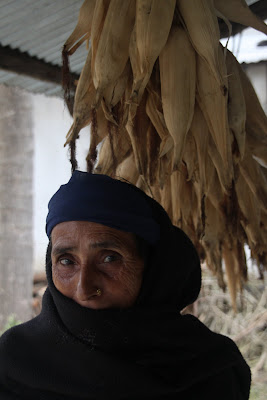Interviews were conducted in some of the most unusual settings, which were often the places of work and/or habitation for the clients. They varied from roadside fires to restaurant-cum-single room homes of thatched straw, where animals for the menu’s meat dishes scuttled around freely until placement of the next order. I struggled to hide my alarm when a chicken was grabbed by its feet from under my seat, bokking cacophonously, during an interview. In another instance, I couldn’t help disrupting the entire interview when the mother of all geckos, the size of an infant alligator, appeared from behind a client’s couch as it made its way up the wall at a snail’s pace. I suppose some things just take getting used to!
Tea or chai holds a very dear place in the heart and palate of Nepalese, as it does for most Asians. From Sri Lanka to Afghanistan, chai plays a vital cultural and social role and is the first offering made to guests, customers, and clients alike before commencement of a meal or meeting. Consistent with this, many of our clients, some of the poorest in their communities, served us chai mixed with milk and sugar, during the interviews. Though I had to be conscious of what I was putting into my body, considering that most of the water consumed by these communities would not be considered potable by UN standards, I still forced myself to take a few sips in order to welcome their hospitality and shed a little bit of the unspoken barriers between me and them.
In all honesty, 60-90 minute interviews are not nearly sufficient to get a true sense of both the financial and social conditions of individuals living in rural communities, and this is for several reasons. Trust is one of the most obvious barriers to overcome, and this can only be built with time and regular interaction with the clients in order for them to share the irregular or intimate details of their lives. For example, when assessing how savings and credit and cooperative membership has empowered women in communities where women have traditionally been viewed and treated as subordinates to their male counterparts, only rarely have they felt comfortable enough to share their stories of abuse, both verbal and physical, and any transformation that has occurred as a result of becoming financial contributors to their households. In this same context, the defining of concepts and methods of perception are a second type of barrier. How does one assess whether these services have served as a catalyst for social empowerment? In such instances, language and tact serve as critical tools. When discussing these issues with Dalit (“untouchable”) and female clients, we often try to assess changes in ‘empowerment’ and ‘leadership’ by gauging clients’ participation in community activities, community and household level decision-making, and perceptions of respect from the community, the family, and the self. While completion of the questionnaire is a requirement in the data collection process, the most invaluable information flows from the stories and reminiscence of the clients as they ponder over the most significant transformations that have taken place in their lives.
The third most noteworthy challenge has been the level of financial literacy of the clients. Household (HH) income is an aggregate figure that takes into account the multiple sources of income generated by rural, poor, and/or disadvantaged HHs. Individual income from daily wage labor or a regular salaried job has solely comprised HH income only in a minority of cases. Most clients in Nawalparasi and Kapilvastu districts cultivate land for agricultural production that is consumed by the HH and/or sold in the market. Similarly, most clients, regardless of their microenterprise, generate an income from livestock production and its byproducts (e.g., meat, milk, ghee, etc.). Collecting this information individually involved clients having to conceptualize income in the same manner as the interviewer, which proved to be a painstaking exercise. When it came to questions on savings, most interviewees didn’t know how to respond when asked how much money was put aside as savings and where these monies were kept. Some may have been kept in a savings and credit cooperative, but what about the small notes sown into a mattress or tied inside the pallu of a sari? Again, language and tact played a crucial role in collecting this information, and I am grateful for having a translator accompany me on these interviews.
At the conclusion of the last day of field interviews, the team made its way back to Gaindakot, this time in a crowded public bus that had exceeded its capacity in both weight and density. After being upgraded from standing amidst an uncountable number of individuals, strange heads resting on my shoulders, to an aisle seat full of confrontations with wailing babies and elbows, it gave me an unexpected opportunity to reflect on all that I have seen and experienced in these last few months. What I have been exposed to is not the exception but a reality for most of the world’s population, and I don’t think I ever fully grasped this until I was actually thrown into its tumult.
It’s been an unforgettable ride, and the experiences derived from it all comprise my life in Nepal these last four months, my motorcycle diaries.























